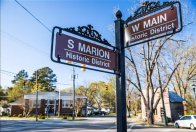A Glimpse of the Past in Historical Latta, South Carolina
Story Narrative:
Students from Latta Middle School tell the story of Latta, South Carolina, through pictures. They highlight people such as the first postmaster, Robert Rose Bethea, an African American merchant appointed to the task in 1890. Special attention is also given to the unique history of Carnegie public libraries in the state and the historic location of the Dillon County Museum.
This story was created in collaboration with the Dillon County Theatre Association for Museum on Main Street's Stories: YES program.
Media Files:
-
Hear about Latta, South Carolina
-
Latta, South Carolina




